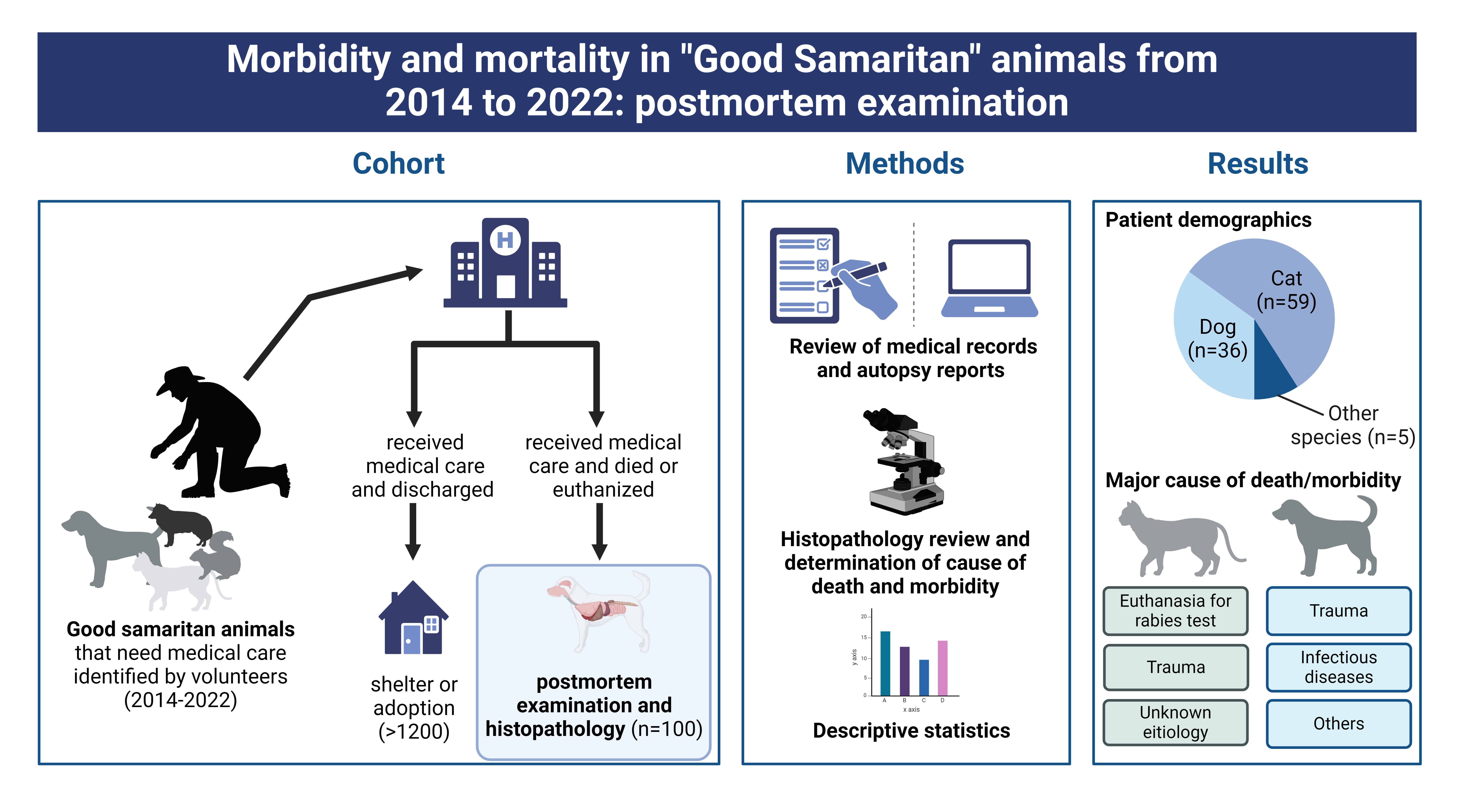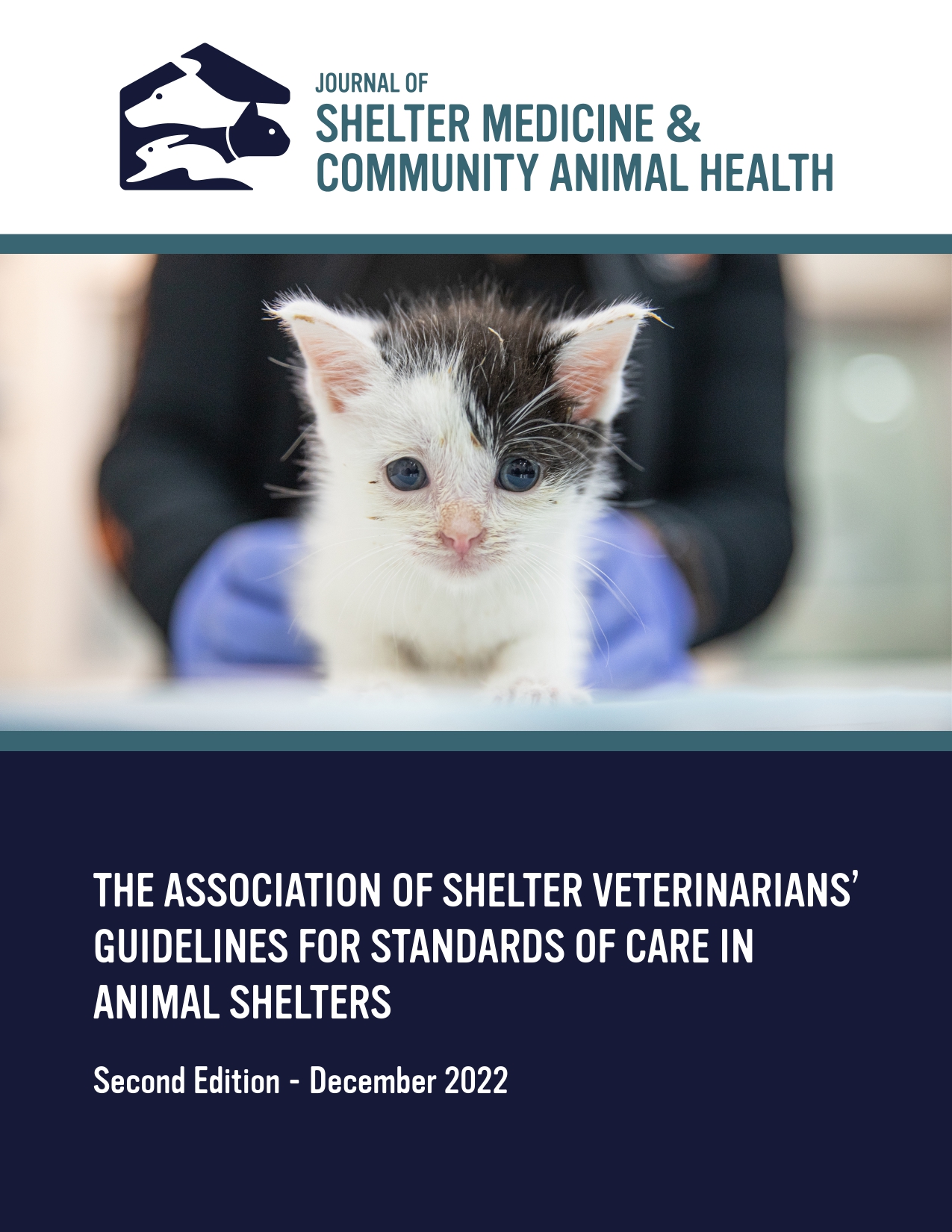A Retrospective Review of Morbidity and Mortality in ‘Good Samaritan’ Animals Admitted to a Tertiary Referral Veterinary Health Center From 2014 to 2022: Postmortem Examination
DOI:
https://doi.org/10.56771/jsmcah.v3.83Keywords:
Good Samaritan animals, trauma, infectious disease, stray animalsAbstract
Introduction: Good Samaritan animals are frequently encountered at veterinary teaching hospitals and provide a useful indirect surveillance tool for monitoring major morbidity and mortality in unattended animals.
Methods: Retrospective study. Good Samaritan animals’ medical and postmortem examination records were searched from the OSU VMC medical record database and the OSU CVM Anatomic pathology database and identified 100 cases from 2014 to 2022.
Results: One hundred Good Samaritan animals that underwent postmortem examination were identified. These included 59 cats, 36 dogs, 2 raccoons, 1 squirrel, 1 bat, and 1 opossum with mean and median ages of 2.61 years and 1 year, respectively. The most predominant cause of death or major morbidity requiring euthanasia was euthanasia for rabies test (n = 19) in cats and vehicular trauma (n = 16) in dogs. Other mortality and significant morbidities include trauma (n = 15) followed by infectious disease (n = 5) in cats and infectious disease (n = 12) and neoplasia (n = 2) in dogs. Brain tissue from 51 animals was submitted to the Ohio Department of Health for rabies tests, and all had negative results. In 17 canines and felines with infectious diseases, dogs had viral (n = 6), parasitic (n = 5), and bacterial (n = 1) etiologies, while cats had bacterial (n = 2) and viral (n = 1), fungal (n = 1), and mixed (n = 1) etiologies.
Conclusion: Epidemiological review of morbidity and mortality in Good Samaritan animals submitted for postmortem examination helps to characterize the types and severity of vehicular trauma and infectious diseases in stray animals. Young and intact animals were important demographic factors in Good Samaritan dogs and cats. The rabies test results tightly correlate with a trend of rabies test results in dogs and cats in Franklin County.
Downloads
References
Good Samaritan Law. American Animal Hospital Association Web site. Accessed Oct 23, 2022. https://www.aaha.org/about-aaha/aaha-position-statements/good-samaritan-law/
Kahler SC. Good Samaritan Laws Protect Responders. American Veterinary Medical Association Web site. Accessed Oct 23, 2022. https://www.avma.org/javma-news/2018-02-15/good-samaritan-laws-protect-responders
Ohio Revised Code. (n.d.). Emergency Medical Attention to Dog or Cat. Section 4765.52. Accessed Sep 11, 2024. https://codes.ohio.gov/ohio-revised-code/section-4765.52
Fontes GS, McCarthy RJ, Kutzler MA, Zitek-Morrison E. The effects of sex and neuter status on trauma survival in dogs: a veterinary committee on trauma registry study. J Vet Emerg Crit Care (San Antonio). 2022;32(6):756–763. doi: 10.1111/vec.13210
Lee JA, Huang C, Hall KE. Epidemiology of severe trauma in cats: an ACVECC VetCOT registry study. J Vet Emerg Crit Care (San Antonio). 2022;32(6):705–713. doi: 10.1111/vec.13229
Grieco V, Crepaldi P, Giudice C, et al. Causes of death in stray cat colonies of Milan: a five-year report. Animals (Basel). 2021;11(11):3308. doi: 10.3390/ani11113308
Streeter EM, Rozanski EA, Laforcade-Buress Ad, Freeman LM, Rush JE. Evaluation of vehicular trauma in dogs: 239 cases (January-December 2001). J Am Vet Med Assoc. 2009;235(4):405–408. doi: 10.2460/javma.235.4.405
Boysen SR, Rozanski EA, Tidwell AS, Holm JL, Shaw SP, Rush JE. Evaluation of a focused assessment with sonography for trauma protocol to detect free abdominal fluid in dogs involved in motor vehicle accidents. J Am Vet Med Assoc. 2004;225(8):1198–1204. doi: 10.2460/javma.2004.225.1198
Intarapanich NP, McCobb EC, Reisman RW, Rozanski EA, Intarapanich PP. Characterization and comparison of injuries caused by accidental and non-accidental blunt force trauma in dogs and cats. J Forensic Sci. 2016;61(4):993–999. doi: 10.1111/1556-4029.13074
Spackman CJ, Caywood DD, Feeney DA, Johnston GR. Thoracic wall and pulmonary trauma in dogs sustaining fractures as a result of motor vehicle accidents. J Am Vet Med Assoc. 1984;185(9):975–977.
Ressel L, Hetzel U, Ricci E. Blunt force trauma in veterinary forensic pathology. Vet Pathol. 2016;53(5):941–961. doi: 10.1177/0300985816653988
Leung T, Davis SA. Rabies vaccination targets for stray dog populations. Front Vet Sci. 2017;4:52. doi: 10.3389/fvets.2017.00052
Rabies and Animal Bites. Ohio Department of Health Web site. Accessed Aug 23, 2023. https://odh.ohio.gov/know-our-programs/zoonotic-disease-program/diseases/rabies.
Singh AJ. Translocation of a Stray Cat Infected with Rabies from North Carolina to a Terrestrial Rabies-Free County in Ohio, 2017. MMWR. Morbidity and Mortality Weekly Report Web site. Accessed Oct 16, 2023. https://www.cdc.gov/mmwr/volumes/67/wr/mm6742a2.htm
Oral Rabies Vaccination Campaign. Ohio Department of Health; 2023. Ohio Department of Health Web site. Accessed Oct 16, 2023. https://odh.ohio.gov/know-our-programs/zoonotic-disease-program/news/oral-rabies-vaccination
Foroutan P, Meltzer MI, Smith KA. Cost of distributing oral raccoon-variant rabies vaccine in Ohio: 1997–2000. J Am Vet Med Assoc. 2002;220(1):27–32. doi: 10.2460/javma.2002.220.27
Ramey PC, Blackwell BF, Gates RJ, Slemons RD. Oral rabies vaccination of a Northern Ohio raccoon population: relevance of population density and prebait serology. J Wildl Dis. 2008;44(3):553–568. doi: 10.7589/0090-3558-44.3.553
Centers for Disease Control and Prevention (CDC). Update: Raccoon rabies epizootic – United States and Canada, 1999. MMWR Morb Mortal Wkly Rep. 2000;49(2):31–35.
Lechner ES, Crawford PC, Levy JK, Edinboro CH, Dubovi EJ, Caligiuri R. Prevalence of protective antibody titers for canine distemper virus and canine parvovirus in dogs entering a Florida animal shelter. J Am Vet Med Assoc. 2010;236(12):1317–1321. doi: 10.2460/javma.236.12.1317
Duijvestijn MBHM, Schuurman NNMP, Vernooij JCM, et al. Serological survey of retrovirus and coronavirus infections, including SARS-CoV-2, in rural stray cats in the Netherlands, 2020–2022. Viruses. 2023;15(7):1531. doi: 10.3390/v15071531
Spada E, Proverbio D, Pepa Ad, et al. Seroprevalence of feline immunodeficiency virus, feline Leukaemia virus and toxoplasma Gondii in stray cat colonies in northern Italy and correlation with clinical and laboratory data. J Feline Med Surg. 2012;14(6):369–377. doi: 10.1177/1098612X12437352
Abu-Madi MA, Pal P, Al-Thani A, Lewis JW. Descriptive epidemiology of intestinal helminth parasites from stray cat populations in Qatar. J Helminthol. 2008;82(1):59–68. doi: 10.1017/S0022149X07870830
O’Lorcain P. Epidemiology of toxocara spp. in stray dogs and cats in Dublin, Ireland. J Helminthol. 1994;68(4):331–336. doi: 10.1017/s0022149x00001590
Raza A, Rand J, Qamar AG, Jabbar A, Kopp S. Gastrointestinal parasites in shelter dogs: occurrence, pathology, treatment and risk to shelter workers. Animals (Basel). 2018;8(7):108. doi: 10.3390/ani8070108
Dinnage JD, Scarlett JM, Richards JR. Descriptive epidemiology of feline upper respiratory tract disease in an animal shelter. J Feline Med Surg. 2009;11(10):816–825. doi: 10.1016/j.jfms.2009.03.001
Otranto D, Dantas-Torres F, Mihalca AD, Traub RJ, Lappin M, Baneth G. Zoonotic parasites of sheltered and stray dogs in the era of the global economic and political crisis. Trends Parasitol. 2017;33(10):813–825. doi: 10.1016/j.pt.2017.05.013
Campanale DN, Walden HDS, Garcia LN, Crawford PC, Hernandez JA. Zoonotic and non-zoonotic intestinal parasites in shelter dogs at admission and before discharge. J Shelter Med Commun Anim Health. 2023;2:11–21. doi: 10.56771/jsmcah.v2.9
Jimenez-Coello M, Ortega-Pacheco A, Guzman-Marin E, Guiris-Andrade DM, Martinez-Figueroa L, Acosta-Viana KY. Stray dogs as reservoirs of the zoonotic agents Leptospira interrogans, Trypanosoma cruzi, and aspergillus spp. in an urban area of Chiapas in southern Mexico. Vector Borne Zoonotic Dis. 2010;10(2):135–141. doi: 10.1089/vbz.2008.0170
Lefkaditis MA, Athanasiou LV, Ionicã AM, et al. Ectoparasite infestations of urban stray dogs in Greece and their zoonotic potential. Trop Biomed. 2016;33(2):226–230.
Liu Y, Zheng G, Alsarakibi M, et al. The zoonotic risk of Ancylostoma ceylanicum isolated from stray dogs and cats in Guangzhou, South China. Biomed Res Int. 2014;2014:208759. doi: 10.1155/2014/208759
Paoletti B, Traversa D, Iorio R, et al. Zoonotic parasites in feces and fur of stray and private dogs from Italy. Parasitol Res. 2015;114(6):2135–2141. doi: 10.1007/s00436-015-4402-6
Shin S, Oh D, Ahn K, et al. Zoonotic intestinal trematodes in stray cats (Felis catus) from riverside areas of the republic of Korea. Korean J Parasitol. 2015;53(2):209–213. doi: 10.3347/kjp.2015.53.2.209
Tabatabaie F, Nasirikaleybar Y, Mohebali M, et al. Serological and molecular survey of zoonotic visceral leishmaniasis in stray dogs (Canis familiaris) from an endemic focus in Meshkin-Shahr district in Ardabil Province, Iran. J Vector Borne Dis. 2021;58(3):213–218. doi: 10.4103/0972-9062.325636
Edwards TH, Scott LLF, Gonyeau KE, Howard EH, Parker JS, Hall K. Comparison of trauma sustained by civilian dogs and deployed military working dogs. J Vet Emerg Crit Care (San Antonio). 2021;31(4):498–507. doi: 10.1111/vec.13064
Davros AM, Gregory CW, Cockrell DM, Hall KE. Comparison of clinical outcomes in cases of blunt, penetrating, and combination trauma in dogs: a VetCOT registry study. J Vet Emerg Crit Care (San Antonio). 2023;33(1):74–80. doi: 10.1111/vec.13253
Simpson SA, Syring R, Otto CM. Severe blunt trauma in dogs: 235 cases (1997–2003). J Vet Emerg Crit Care (San Antonio). 2009;19(6):588-602. doi: 10.1111/j.1476-4431.2009.00468.x
Fisher CJ, Cavanagh AA, Liss D, Adams T, Marvel SJ, Hall KE. Surgical interventions and outcome in a population of feline trauma patients. J Vet Emerg Crit Care (San Antonio). 2023;33(3):337–347. doi: 10.1111/vec.13291
Rockar RA, Drobatz KS, Shofer FS. Development of A scoring system for the veterinary trauma patient. J Vet Emerg Crit Care. 1994;4(2):77–83. doi: 10.1111/j.1476-4431.1994.tb00118.x

Additional Files
Published
Issue
Section
License
Copyright (c) 2024 Yea Ji Jeong, Christopher Premanandan, Jiwoong Her

This work is licensed under a Creative Commons Attribution 4.0 International License.









